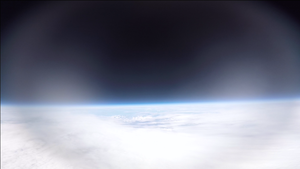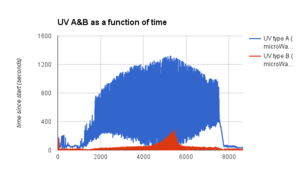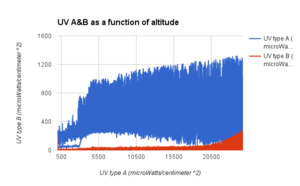Difference between revisions of "Project UV"
| Line 4: | Line 4: | ||
== Chemical protection== | == Chemical protection== | ||
| + | [[File:SSI_UV_00.png | left | thumb| <center> Preliminary data</center>]] | ||
Because ultra violet radiation physically degrades the polymers within the latex, a chemical solution may elongate its lifespan. | Because ultra violet radiation physically degrades the polymers within the latex, a chemical solution may elongate its lifespan. | ||
| − | A preliminary test was done with a set of various chemical coatings, balloon types, and strech values. | + | A preliminary test was done with a set of various chemical coatings, balloon types, and strech values. However, the test had to be stopped for winter break, so the degradation point of some samples could only be predicted, not verified. Nevertheless, the initial results seem optimistic. |
== SSI-28 == | == SSI-28 == | ||
Revision as of 07:47, 1 February 2016
Project UV is the 2015-2016 Balloons team project to develop effective countermeasures against the UV degradation of latex balloons, in order to increase the potential flight time of future payloads.
The current team leads are Davy Ragland and Yuji Sugimoto.
Chemical protection
Because ultra violet radiation physically degrades the polymers within the latex, a chemical solution may elongate its lifespan. A preliminary test was done with a set of various chemical coatings, balloon types, and strech values. However, the test had to be stopped for winter break, so the degradation point of some samples could only be predicted, not verified. Nevertheless, the initial results seem optimistic.
SSI-28
In order to collect data on the levels of ultra violet A and B present at different altitudes, a sensor for each UV type was launched on SSI-28. From the data, it can be concluded that there is much more UV A than UV B, and it does in fact increase with altitude, reaching a max value of 1323 microwatts/cm^2 for UV A and 292 microwatts/cm^2 for UV B. In addition, there is a lot of noise in the values, with a corresponding oscillation of values, which is due to the sensor being on one side, and the payload spinning during its flight. Thus, the value where the sun is directly facing the latex would correspond to the high part of the wave.
Gallery
| Balloon Launches | |
|---|---|
| 2014-15 | SSI-19 • 20 • 21 • 22 |
| 2015-16 | SSI-23(a) • 24 • 25 • 26 • 27 • 28 • 29 • 30 • 31 • 32 • 33 • 34 • 35 • 36 • 37 • 38 • 39 • 40 • 41 • 42 • 43 |
| 2016-17 | 44 • 45 • 46 • 47 • 48 • 49 • 50 • 51 • 52 |
| 2017-18 | |
| 2018-19 | 83 • 86 • 87 • 90 • 91 |
| 2019-20 | 92 • 93 • 97 |
| V • E | |



